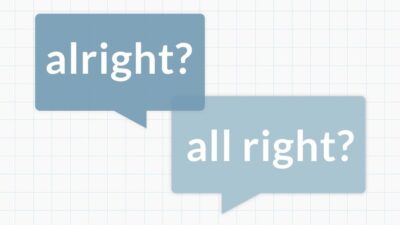Language is a dynamic and ever-evolving entity, constantly shaped by cultural influences, colloquial usage, and individual preferences. In the vast ocean of words, phrases, and expressions, there exist subtle nuances that may escape the casual observer but play a crucial role in conveying meaning.
One such linguistic conundrum that often sparks debates and raises eyebrows is the distinction between all right and alright.
While seemingly interchangeable at first glance, these two expressions have triggered discussions among grammarians, language enthusiasts, and everyday communicators alike.
In this article, we delve into the origins, usage patterns, and the evolving acceptance of “alright” as an alternative to the more traditional “all right.” As we navigate the intricacies of language, we’ll uncover the factors contributing to the divergence and convergence of these seemingly synonymous terms.
Usage of All Right and Alright

The usage of “all right” and “alright” can be a bit nuanced, often depending on context, formality, and regional variations.
“All right” is considered the standard and more traditional spelling. It’s widely accepted in formal writing and tends to be the preferred choice when precision and formality are required. For instance:
- “She performed all right in her exams.”
- “Is everything all right with the project?”
On the other hand, “alright” is a more informal variant that has gained acceptance in casual speech and writing, especially in informal contexts like dialogue or artistic expression. While it’s commonly used in everyday conversations, its usage in formal writing is still debated among language purists. Examples include:
- “It’s going to be alright, don’t worry.”
- “He sings alright, but his guitar playing is exceptional.”
The distinction between the two is not always strict, and in many cases, they can be used interchangeably without changing the meaning significantly. However, it’s important to note that “alright” might be considered less formal or even incorrect in certain settings that demand adherence to strict grammatical rules.
Ultimately, choosing between “all right” and “alright” often boils down to context, audience, and the desired tone of communication. In formal or professional settings, sticking to “all right” is generally advisable, while “alright” finds its place comfortably in casual conversations or less formal writing.
Watch this video on the right usage of all right and alright – Source
All Right
The phrase “all right” has a long and storied history, dating back to the 16th century. It originated as a fusion of the Middle English word “al,” meaning entirely, and “right,” denoting correctness or appropriateness.
Over time, this combination evolved into the contemporary expression we use today. The concept of being entirely correct or suitable encapsulated the essence of “all right,” making it a versatile and enduring term.
Grammatical Considerations and Acceptance
From a grammatical standpoint, “all right” is considered the standard and grammatically correct form. As a two-word phrase, each component plays a distinct role — “all” as an adverb and “right” as an adjective. This grammatical structure aligns with traditional English usage and contributes to the acceptance of “all right” in formal language.
While language evolves, “all right” remains a stalwart construction that withstands the test of time, maintaining its grammatical integrity across various registers of English.
Formal and Academic Contexts Where “All Right” is Preferred
In formal and academic writing, precision and adherence to grammatical norms are paramount. Consequently, “all right” is the preferred choice in these contexts. Whether crafting a scholarly paper, a business report, or any document that demands a high level of formality, opting for “all right” enhances the professionalism and correctness of the language used.
In academic discourse, clarity and precision are vital, and the use of established language conventions, such as “all right,” contributes to effective communication. This traditional choice reflects a commitment to linguistic accuracy and aligns with the expectations of formal writing standards.
Alright
The emergence of “alright” as an alternative to “all right” can be traced to the informal evolution of language. Over time, speakers seeking brevity and informality began to adopt “alright” as a single-word substitute. Its informal nature makes it well-suited for everyday conversations, contributing to its gradual acceptance in casual speech.
The fusion of “all” and “right” into a single word aligns with the trend of linguistic simplification, where efficiency often takes precedence over strict adherence to formal grammatical norms.
Linguistic Debates and Acceptance in Modern Usage
The acceptance of “alright” has sparked linguistic debates among grammarians, language purists, and enthusiasts. Traditionalists argue that “all right” is the grammatically correct form, while others contend that language evolves, and informal expressions like “alright” are valid adaptations that reflect contemporary usage.
Modern dictionaries and style guides increasingly acknowledge “alright” as an acceptable variant, recognizing its prevalence in informal communication. However, debates persist, and the acceptance of “alright” in formal writing remains a point of contention, with some style guides continuing to favor the more traditional “all right.”
Popularity in Literature, Media, and Casual Communication
Despite the debates, “alright” has gained popularity in literature, media, and casual communication. Writers and content creators often use “alright” to convey a sense of informality, dialogue authenticity, or to capture the nuances of colloquial speech. Its single-word form lends itself well to dialogue in fiction, film scripts, and informal blog posts.
In media, “alright” is frequently employed in headlines, song lyrics, and social media posts, further solidifying its place in contemporary language. Its popularity in casual communication reflects the dynamic nature of language, where expressions that resonate with everyday speakers often find their way into common usage, challenging established norms.
The right usage of all right vs alright
The choice between “all right” and “alright” depends on the style guide you’re following and the context in which you’re writing. Generally, “all right” is considered more formal and standard, while “alright” is often considered informal or colloquial. Some style guides, however, accept “alright” as a variant in informal contexts.
Here are examples of both:
- All Right:
-
- Everything will be all right.
- Is it all right if I come over later?
- Alright:
-
- It’s alright if you can’t make it to the party.
- The movie was alright, but I’ve seen better.
In formal writing, such as academic papers or professional documents, it’s recommended to use “all right.” If you’re writing informally or in a creative context, “alright” may be acceptable, but it’s essential to be consistent in your usage. Always check the style guide or the preferences of your audience if you’re uncertain about which one to use.
Common Mistakes and Misconceptions about all right vs alright

There are some common mistakes and misconceptions regarding the usage of “all right” and “alright.” Here are a few to be aware of:
- Mixing Formality:
- Mistake: Using “alright” in formal or professional writing.
- Clarification: In formal contexts, it’s generally recommended to use “all right.” “Alright” is more acceptable in informal writing.
- Regional Differences:
- Mistake: Assuming that one form is universally correct in all English-speaking regions.
- Clarification: “Alright” is often considered more acceptable in American English, while British English tends to prefer “all right.” However, this is a generalization, and both forms are understood in both dialects.
- Consistency:
- Mistake: Inconsistently using both “all right” and “alright” within the same piece of writing.
- Clarification: It’s essential to be consistent in your choice throughout a document or text. Pick one form and stick with it to maintain clarity and professionalism.
- Formal vs. Informal Context:
- Mistake: Using “alright” in situations where formality is required.
- Clarification: In more formal contexts, such as academic or business writing, it’s advisable to use the two-word form “all right.” “Alright” is generally more appropriate in casual or conversational settings.
- Acceptance in Informal Settings:
- Mistake: Assuming that “alright” is universally accepted in all informal contexts.
- Clarification: While “alright” is more informal, it’s not universally accepted in all informal writing. Some style guides and individuals may still prefer the more traditional “all right.”
To avoid these mistakes, it’s always a good idea to be aware of your audience and the context in which you are writing. If you are uncertain, consulting a style guide or reference source can provide guidance on the preferred usage in specific situations.
Conclusion
This page answers all your question on the differences and usage of all right vs alright. The choice between “all right” and “alright” depends on the context and formality of your writing. “All right” is generally considered more formal and is preferred in formal settings, while “alright” is often used in informal or conversational contexts.
However, it’s crucial to be consistent within a piece of writing and to consider the preferences of your audience or the style guide you are following. Ultimately, both forms are understood in English, but being mindful of their usage enhances clarity and appropriateness in communication.

